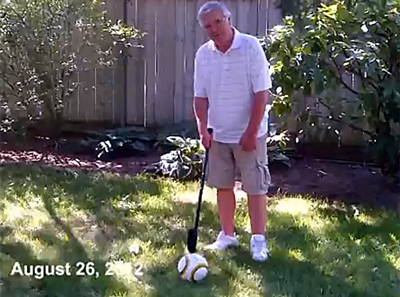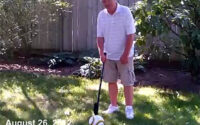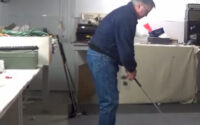Rehab after a stroke

Anyone who has had a stroke and has a realistic chance of recovering all or some of the faculties they’ve lost becomes something of an expert in various therapies.
Of course the therapists I’ve known and worked with at agapetc.com are all sincere, dedicated and well-meaning to be sure – are pretty unanimous in saying “everyone’s different”. So what works for one stroke victim will not necessarily work for any or all others.
I am prepared to accept this (“everyone’s different”) up to a point, because having met quite a few stroke victims, it is obvious that every stroke is different, and affects its unlucky victim in different ways and to different degrees.
But having said that, it is also fairly obvious that there are many similarities between stroke victims. Many have suffered from the same affects, and you’d have to think will respond in similar ways to similar therapies. Perhaps to different degrees and at different rates. But that goes almost without saying.
So that leads me to share some of the first hand “expertise” I’ve developed over the last seven months. I’ve shared most of these thoughts with many of my friends and family (more than once I’m afraid), so excuse me if you’ve already heard it.
1. The amount of improvement (in say, learning to walk, kick a soccer ball, or hit a golf ball again) is NOT only related to the amount of effort and practice you put in. There is SOME relationship between effort and improvement, but it is not a simple one. There are other factors involved, and perhaps the most important one is just TIME.
2. What is going on is a healing process. Healing takes time. Just as when you rehab a broken arm or leg the process involves both time and work, so too with injuries due to stroke – essentially injuries to the brain. The brain has to heal itself.
3. If you were to graph a stroke victim’s improvement, it would look like the famous “hockey stick” graph used by Al Gore to show the (questionable) proportion over time of carbon dioxide in the atmosphere. In the case of stroke victims the rate of improvement in any given area or type of activity would be much greater near the beginning. After a certain point in time things level off, and improvement becomes much less pronounced.
For example, I started to get serious movement in the fingers of my left hand more than three months ago – that was when I could first tie my shoes – what seemed like a major breakthru at the time. Previous to that I had very little useful movement in those fingers.
But since then the improvement has been painfully slow. I could type a few sentences on the computer for the first time a couple of months ago. But my ability to type has not improved a great deal since then. My fingers remain relatively stiff and difficult to control. I’ll admit I haven’t made a point of working at my typing. But I have made a point of working at my guitar playing, as much as I can, every day, and in particular I have worked on strengthening my ring and little fingers. But they remain surprisingly resistant to improvement. I’ve come to accept that it is just a matter of time + work. I could be wrong, but I doubt that I will recover reasonable strength in those fingers without both components: time + work.
4. There are major factors involved in a stroke victim’s willingness to “work” at improving…
First, they need the will to put out the effort. I’m sure there are many who just can’t bring themselves to work at it – just like many people can’t bring themselves to do their homework, or practise the piano.
Second, they need the time. Many people, including many stroke victims, have to work to survive. Fortunately I was self employed, and was able to effectively “retire”, so, mercifully, work has not been an issue for me.
Third, they need the support. Going to rehab, or a gym to work on the equipment, or swimming or walking at the Y… most stroke victims need help in getting around. In many cases (as in mine) it’s your spouse. But what if your spouse is working, or unwilling to ferry you around, or you have no spouse. It becomes quite a bit more complicated then.
Fourth, they need the energy. It’s fine and dandy to have a rehab plan. That plan will probably include regular walking, possibly swimming or lifting weights. It could also include speech therapy, or music therapy, or, in my case, things like typing, playing the guitar, kicking a soccer ball around, and regularly hitting golf balls into a net in my basement. But all these things take energy. It is estimated that it takes at least twice as much energy for a stroke victim to walk than it does a normal person. 10 or 15 minutes on a treadmill doesn’t seem like much but it is just about all a typical stroke victim can take. Surprising as it may seem, simple typing is one of the most exhausting activities I do.
Bottom line… it ain’t easy, but you just have to keep pluggin.
It could always be a lot worse.




I would suggest that the healing will indeed take ‘ time ‘ and that the healing process might occur in plateaus instead of in a straight line , if plotted on a time vs mobility/ strength / endurance graph . This idea is accepted by many gurus in health and strength training . You may struggle to do x number of reps at a certain weight for a few weeks but with the at least equally important factors of rest and nutrition , you will walk up to that weight one day when you are particularily energetic , and do those reps and more, with ease , and you are off to the next plateau. The all important factor is , of course , TIME , time to heal the tissues that have been broken down by the injury whether self inflicted through work outs or by a traumatic injury . The key of course , is to persevere.
As ‘ Red ‘ said in the film , Shawshank Redemption , if you`re not busy livin` , then you`re busy dyin` !